77810
Atto 520 NHS ester
BioReagent, suitable for fluorescence, ≥90% (HPLC)
About This Item
Polecane produkty
linia produktu
BioReagent
Próba
≥90% (HPLC)
≥90% (degree of coupling)
Postać
powder
producent / nazwa handlowa
ATTO-TEC GmbH
λ
in ethanol (with 0.1% trifluoroacetic acid)
absorpcja UV
λ: 526-532 nm Amax
przydatność
suitable for fluorescence
metoda wykrywania
fluorometric
temp. przechowywania
−20°C
ciąg SMILES
[O-]Cl(=O)(=O)=O.CCNc1cc2OC3=CC(=[NH+]\CC)\C(C)=CC3=C(CCC(=O)ON4C(=O)CCC4=O)c2cc1C
InChI
1S/C26H29N3O5.ClHO4/c1-5-27-20-13-22-18(11-15(20)3)17(7-10-26(32)34-29-24(30)8-9-25(29)31)19-12-16(4)21(28-6-2)14-23(19)33-22;2-1(3,4)5/h11-14,27H,5-10H2,1-4H3;(H,2,3,4,5)/b28-21-;
Klucz InChI
HVCUIKJJDQLPQR-AYYDQZPKSA-N
Szukasz podobnych produktów? Odwiedź Przewodnik dotyczący porównywania produktów
Zastosowanie
Informacje prawne
Kod klasy składowania
13 - Non Combustible Solids
Klasa zagrożenia wodnego (WGK)
WGK 3
Temperatura zapłonu (°F)
Not applicable
Temperatura zapłonu (°C)
Not applicable
Środki ochrony indywidualnej
Eyeshields, Gloves, type N95 (US)
Certyfikaty analizy (CoA)
Poszukaj Certyfikaty analizy (CoA), wpisując numer partii/serii produktów. Numery serii i partii można znaleźć na etykiecie produktu po słowach „seria” lub „partia”.
Masz już ten produkt?
Dokumenty związane z niedawno zakupionymi produktami zostały zamieszczone w Bibliotece dokumentów.
Klienci oglądali również te produkty
Produkty
Chromogenic and fluorogenic derivatives are invaluable tools for biochemistry, having numerous applications in enzymology, protein chemistry, immunology and histochemistry.
Pochodne chromogeniczne i fluorogeniczne są nieocenionymi narzędziami w biochemii, mającymi liczne zastosowania w enzymologii, chemii białek, immunologii i histochemii.
Nasz zespół naukowców ma doświadczenie we wszystkich obszarach badań, w tym w naukach przyrodniczych, materiałoznawstwie, syntezie chemicznej, chromatografii, analityce i wielu innych dziedzinach.
Skontaktuj się z zespołem ds. pomocy technicznej




![4-[4-(Dimethylamino)phenylazo]benzoic acid N-succinimidyl ester ≥98.0% (HPLC)](/deepweb/assets/sigmaaldrich/product/structures/120/235/500b5276-3ce2-43b7-9588-3883f13d4ff7/640/500b5276-3ce2-43b7-9588-3883f13d4ff7.png)

